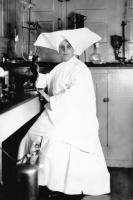Daughters Of Charity Serve Historic Medical Mission In Louisiana

Editor’s Note: Beginning in the late 9th Century, the Daughters of Charity provided groundbreaking medical service in Louisiana to victims of Leprosy. The Message is grateful to the Daughters for providing this account of the Sisters’ landmark service and the accompanying photos, all courtesy of the Provincial Archives of the Daughters of Charity in Emmitsburg, Md.
Since biblical times the diagnosis of leprosy has struck terror. Today leprosy is different and is technically known as Hansen’s Disease, recognizing the Norwegian Doctor G. Armauer Hansen, M.D., who in 1873 discovered the causing bacillus. This disease attacks nerve endings and destroys the ability to feel pain. Injuries can thus become infected resulting in severe deformities in the hands, feet and face.
The 19th century attitude of ignorance and fear led the Louisiana legislature in 1874 to mandate that all persons with leprosy be isolated and hospitalized in an old smallpox hospital known as the Pest House. More an asylum than a hospital, patients received minimal care. In 1894, the legislature created a Leprosy Control Board that designated an abandoned plantation 85 miles from New Orleans as the new Louisiana Leper Home. After an 18-hour trip by steamer to the old Indian Camp, the first 20 patients found seven dilapidated slave cabins that would serve as their new home.
The appointed physician/administrator was soon overwhelmed. Familiar with the Daughters of Charity at Charity Hospital in New Orleans, the Board set out to seek Sisters to serve these patients. Many volunteered for this mission, and four were chosen: Sister Beatrice Hart for administration, Sister Annie Costello for nursing, Sister Mary Thomas Stockum for nutritional services and Sister Cyril Coupe as designated housekeeper. Two rooms of the immense abandoned plantation mansion were repaired enough to serve as the Sisters abode – but the rats, snakes, and bats that held residence there could not be dislodged. Each Sister kept an axe by her bed to kill the water moccasins nested in the broken plaster.
The arrival of the Sisters was balm from heaven for the patients. Sister Beatrice reported in a letter:
“We went to each one separately and tried to make them feel we were coming to be one with them, to care for them, to make them happy ... to show them the goodness of God their Father providing for them in their suffering and lonely condition.”
With assistance from the Sisters, the patients planted a garden and planned evening entertainments with singing and “Punch and Judy” shows.
While most patients were from Louisiana, by 1916 others had come from St. Louis, Florida, Mexico, Germany, Italy, France, Denmark, Hong Kong, and Norway. In 1921 the Federal Government bought the Louisiana Leper Home and renamed it the United States Marine Hospital No. 66, the National Leprosarium. There were then 90 patients and six Daughters of Charity.
In 1941 the drug Sulfone effected dramatic changes in the side effects of Hansen’s Disease; and in 1947 a Medical Discharge policy permitted patients to return to society. While outpatient treatment became common, many patients chose to remain at Carville, the only home they knew. In 1959 cottages were provided for married couples.
In 1957 the Daughters of Charity were awarded the Distinguished Service Award by the U.S. Department of Health, Education and Welfare “for devoted services to the patients of the leprosarium at Carville and contribution to the success of the unique program at the hospital.” The following year, Sister Hilary Ross, a pharmacist and biochemist, won international acclaim as a leprologist.
Over the years, Carville was the home to 4,500 victims of Hansen’s Disease. Daughter of Charity Sister Michael Friebe, who lives at the Daughters’ Seton Residence in Evansville, served as a nurse in Carville from 1958 to 1963.
More information can be found at:
http://www.knowla.org/entry/57 and http://www.pbase.com/septembermorn/carville


